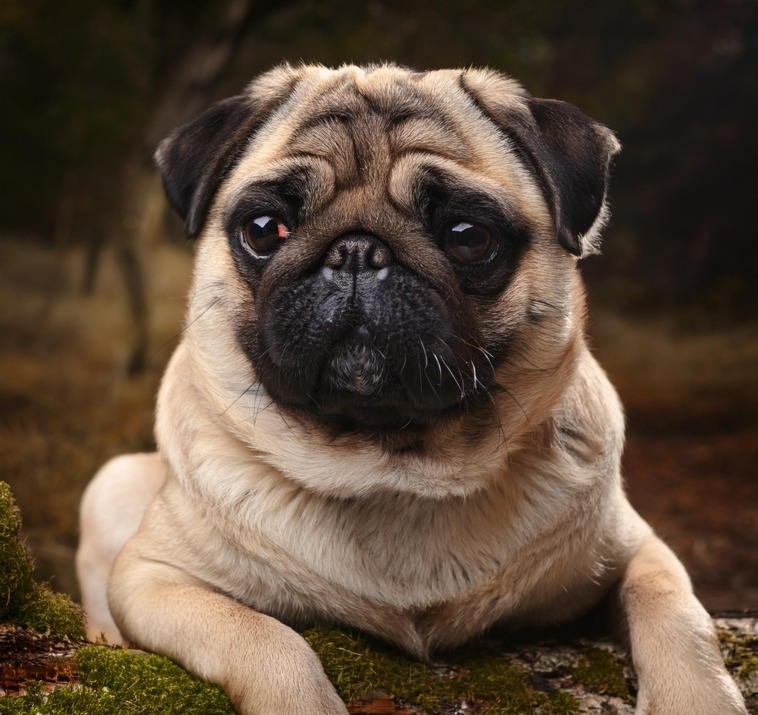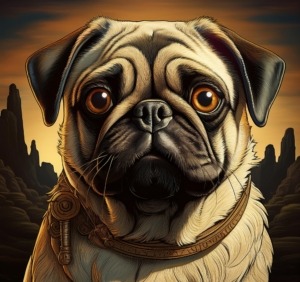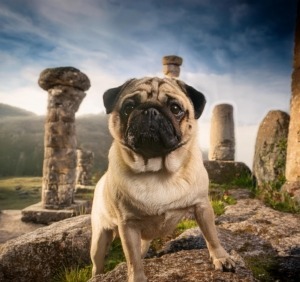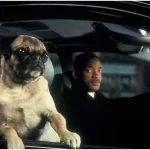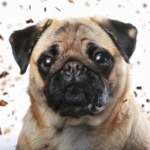Last updated on October 3rd, 2024
Here’s an overview:
Introduction: The Allure of the Pug Breed
The Mystical Beginnings: Pugs in Ancient China
Imperial Companions: A Royal Legacy
The Silk Road and the Spread of the Pug
Pugs in Ancient Art and Culture
Introduction of the Pug Breed to Europe
The Pug During the 18th & 19th Centuries
Modern Development: 20th Century to Present
Characteristics & Traits Rooted in History
Global Popularity: A Cross-Cultural Phenomenon
The Pug’s Role in Contemporary Society
Conclusion: An Ageless Tale of Faithfulness and Friendship
Introduction: The Allure of the Pug Breed
The compact yet solidly built pugs are one breed that has gained global recognition among dog lovers due to their unique charm. Some of their distinctive features include:
- Wrinkled Face : Their expressive countenance has deep facial folds.
- Curly Tail : This breed is known for its double-curled tail.
Pugs have a friendly disposition. They have a reputation for loyalty, affection, and playfulness, making them excellent companions. Their sociable nature makes them ideal pets for family settings. These tiny dogs are smart, with trainability being relatively easy.
The Mystical Beginnings: Pugs in Ancient China
Pugs can be traced back to ancient China around 400 BC (Kolin et al., 2012). At that time, Chinese emperors gave them royal treatment, often housing them in ornate palaces. Referred to as “Lo-sze,” they were frequently depicted in various Chinese works. As a result, pugs became symbols of authority, with imperial families frequently keeping them as cherished pets. They believed that pugs’ wrinkled faces looked like the “prince” in Chinese characters.
Key Facts:
- Originates in ancient China around 400 B.C.
- Known as “Lo-sze” in ancient times.
- Regarded as a status symbol.
- Owned mainly by emperors and their families.
In the ancient Chinese culture, this breed could not miss out due to its looks as well as favorable characteristics.
Imperial Companions: A Royal Legacy
Pugs have shared an aristocratic history with ancient china dating back centuries. The rich kept these small, beautiful dogs as pets, and their presence at ceremonies indicated great wealth and honor. Emperors and royals highly valued them and sometimes granted them special rights.
- Origin: Bred for companionship in ancient China.
- Royal Favor: Pets of emperors, often featured in art.
- Special Privileges: Lived in luxurious palaces.
Merchants and diplomats carried Pugs into Europe where they found favor with European royalty including Queen Victoria and the House of Orange among others thus solidifying their reputation.
The Silk Road and the Spread of the Pug
The development of transcontinental routes such as the Silk Road helped to disseminate cultures, goods, animals which included pug dog’s breed from China into many other countries along those routes. From China pugs travelled westward with businessmen, merchants, travellers etc because of their unique look and friendly nature which made them so desirable all over Asia Minor that Persia became one of main places where these breeds found themselves very popular at once.
- China: Pugs were beloved by Chinese emperors.
- Persia and India: Pugs’ popularity grew due to their unique appearance.
- Europe: By the 16th century, pugs were common in European courts.
The pug was transformed from a Chinese companion to a global symbol of affection and loyalty through the Silk Road.
Pugs in Ancient Art and Culture
Ancient art from different countries has various representations of pugs.
- China: From 206 BC, they were used as decorations in noble families. Pictures of pugs are often found on ancient Chinese artworks alongside emperors.
- Europe: Pug dogs were among the paintings in Renaissance portraits of noblemen and women. They stood for social status and wealth.
- India: Mughal pug dog works focused on their presence within royal courts.
- Japan: Pugs often appeared in Edo Period ink paintings and woodblock prints, illustrating how much they influenced Japanese culture.
Introduction of the Pug Breed to Europe
The European voyagers and traders who first encountered the breed in the 16th century called it a pug.
- Dutch Merchants: The Dutch East India Company merchants played a key role in bringing this dog breed into Europe.
- Royal Adoption: Especially in Holland and England, these dogs became popular among the royal courts.
- William of Orange: The dog’s popularity rose significantly after William of Orange adopted them (he later became King William III of England).
- Artwork & Literature: As symbols of high birth as well as cultured taste, this kind of breed has been frequently appearing in European art work or literature seen by many people through centuries.
The Pug During the 18th & 19th Centuries
During the 18th and 19th centuries, more than any other time period before that saw that pugs were being bred for noble families throughout Europe.
- 18th Century England: It was favored by those from aristocratic families including William III and Queen Victoria.
- Dutch Traders: Introduced from Netherlands in late 16 th century; this eventually influenced its spread and improved status compared to how it was before them.
Often portrayed alongside elite members during this era to signify riches and style.
Modern Development: 20th Century to Present
During the 20th century, advances in veterinary science and evolving aesthetic taste resulted in changes in pug breeding. Breeders concentrated on perfecting distinct facial features and compact body structure.
Health Improvements:
- Immunizations.
- Genetic tests.
Breed Standards:
- Set forth by Kennel Clubs.
- Focus on physical qualities such as wrinkles and curled tails.
Popularity Surge:
- Movies & Media.
- Pugs appeared in movies or commercials; this made them famous among people who love such kinds of films.
They still remain popular pets worldwide even though they are prone to various health issues.
Characteristics & Traits Rooted in History
Pugs have developed distinctive physical and behavioral characteristics from centuries of selective breeding practices.
- Compact Body: This allows them to be very agile with their muscular yet compact frame.
- Wrinkled Face: Such deep creases were aesthetically desirable back then.
- Stubborn Streak: This breed’s occasional stubbornness stems from its very independent character right from the beginning of time.
Global Popularity: A Cross-Cultural Phenomenon
The popularity of the pug breed can cross borders between cultures all over the world which makes it remarkable among other species’ popularity elsewhere globally.
- Ancient China : These animals were highly valued by emperors who believed that they brought them lot of luck and wealth.
- Europe: The popularity of pugs increased during the Renaissance, especially among the aristocracy.
- Netherlands: Prince William reportedly saved a pug’s life, henceforth, they became mascots for the House of Orange.
- United States: After being recognized by the American Kennel Club in 1885, this breed has consistently remained popular and has ranked highly on AKC popularity lists over years.
“Pugs have endearing personalities and adaptable natures that make them universally-loved pets.”
The Pug’s Role in Contemporary Society
These dogs have been comfortably integrated into modern life taking various roles shaped by society.
- Companionship: The affectionate nature of pugs is widely known, making them perfect family pets.
- Therapy Animals: Pugs also function as therapy dogs largely because of their calm nature.
- Adaptive Pets: Pugs do well in urban or country environments and easily fit into various living conditions.
- Fitness Buddies: A healthier life for a pug owner can only be maintained through routine walks and playing games with them.
Conclusion: An Ageless Tale of Faithfulness and Friendship
They have been loyal and loving throughout history. Their ability to transition from palaces to modern-day households is a testimony that these dogs are able to adjust themselves in order to remain relevant even through the tough times as well as the changes resulting from time leading up until today.
These pets still bring joy to families all over the globe. Their playfulness along with their deep connections with people display eternal faithfulness and friendship. In this respect, Pug’s history ensures that it will remain one of the most popular breeds ever known so far.
Article by: Tawab Sukhera (Ethologist)


